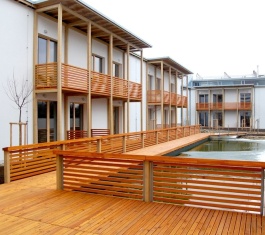
The share of new passive houses in the Czech Republic last year was about 10 percent
Prague - In 2014, approximately 1000 passive family houses were built in the Czech Republic, accounting for about ten percent of all family houses built. Overall, there have been more than 1600 in the country so far. In an interview with ČTK, Jan Bárta, the director of the Passive House Centre, stated this. According to him, a building can be labeled as a passive house if it has very low energy consumption for heating. The key element is heat recovery (so-called recuperation), where a system of pipes exchanges air while heat remains inside. In terms of the share of newly constructed houses, the Czech Republic ranks among the European leaders alongside Austria and Belgium.
"The best recuperation systems have an efficiency of around 96 percent, so almost all the heat stays inside. And the house has fresh air without needing to ventilate. The costs of using the house can be as little as 1000 crowns per month," says Bárta. Moreover, he claims that a passive house does not necessarily have to be more expensive than a conventional construction. "The difference may only be that, unlike standard buildings, technical supervision by the builder is required for passive houses. This can make the construction more expensive. In a normal building, the keys are handed over, and people may not find out for up to two years what was done wrong," he adds.
The first house referred to as passive was built in 1990 in Darmstadt, Germany. Currently, there are an estimated 40,000 passive houses in Germany, the highest in the world. "In the Czech Republic, the first passive houses began to be built about ten years ago. And the biggest boom has occurred so far in 2014 with the launch of the New Green Savings program," recalls Bárta.
"Outside of Europe, we are seeing great interest from China. It can be said that passive houses are spreading all over the world. But their cradle is in Europe, where there are the most of these houses. The climatic conditions here are the most favorable for them. Additionally, there is pressure from the European Union for efficient energy use," mentions Bárta.
According to him, most passive houses are single-family houses, but apartment buildings are also being constructed. "For example, the developer company JRD will complete a large rental building in Hloubětín next year. Other examples include the Elementary Art School in Holice, a kindergarten in Slivenec, a care home for the elderly in Modřice near Brno, and an administrative building in Ostrava. This standard can also be applied to gymnasiums, sports halls, or swimming pools," adds Bárta.
He considers wood to be the ideal material for constructing passive houses. "It has the advantage that in one layer you combine the load-bearing system and thermal insulation. Thus, the outer structure can be thinner, increasing the usable area. Wood has its disadvantages, but so do bricks. Generally, it can be said that a passive house can be built from almost anything," Bárta continues.
He believes that some myths are hindering wider adoption. "For example, that windows cannot be opened, which is nonsense. Or that the controlled ventilation system is a complicated additional technology that requires constant maintenance. It is actually the case that you just change the filter every three months. That takes you five to ten minutes," says Bárta.
According to him, in a few years only passive houses will be built. "According to the European Commission's regulations, buildings with nearly zero energy consumption must be built from 2020 onwards. Each state defines what the term nearly zero means. And then it's just one small step further," concludes Bárta.










